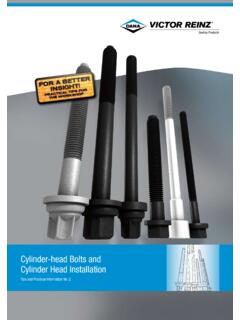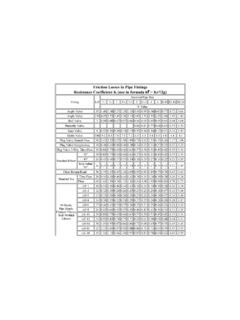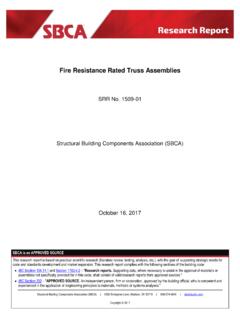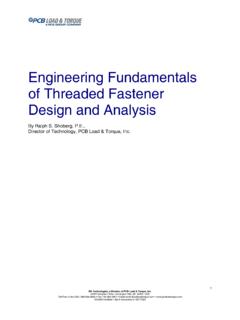Transcription of Fuel Sending Unit Resistance Matching - GoMoG
1 Fuel Sending Unit Resistance Matching Doug Lawson 2/11/2006 This document is to assist the reader in Matching the output Resistance range of a Smiths fuel Sending unit to other brands of instruments. The example used is for the post 1964 BMC/BL/Rover Mini utilizing bimetallic type gauges and the voltage stabilizer. Earlier cars omitted the voltage stabilizer and used magnetic gauges. These are not covered here. The following information is provided to acquaint the reader with the basic mode of operation for bimetallic gauges. The Sending unit in the fuel tank is a variable resistor. One side of the Sending unit should be connected to chassis/earth ground. Some cars achieve the ground connection through the tank itself. Others like the Mini provide a grounding lug and (black) ground wire directly on the Sending unit. The other connection on the Sending unit is typically a green wire with a black tracer stripe.
2 This wire goes to the fuel gauge. There is a second connection on the fuel gauge for a solid green wire. This wire supplies a controlled 10V from the voltage stabilizer. If the stabilizer is broken the gauge will either fail to read at all or will read in excess of 30% too high. The stabilizer is not discussed in detail in this document. Current flowing from the voltage stabilizer passes through the temperature gauge, through the green/black wire, through the fuel Sending unit, and on to chassis ground. The fuel Sending unit is a variable resistor. A wiper connected to the float arm of the Sending unit moves over an internal coil of Resistance wire allowing the device to act as a throttle and control the amount of current flowing through the system. As this current passes through the gauge it is carried by Resistance heating wire wrapped around a bimetallic strip.
3 The bimetallic strip is connected to the needle on the gauge. The flowing current causes heating inside the gauge, bending the bimetallic strip and deflecting the needle. If the Sending unit is not matched to the gauge, the instrument s needle will either be deflected too much or too little. Fuel Sending unit wires connections at the tank. Black = ground/earth Green/Black = wire to fuel gauge. Smiths used Sending units with a variety of operating ranges. On Minis with the voltage stabilizer this was always a Sending unit operating nominally between 0-Ohms = Full and 270-Ohms=Empty. (These are nominal values as will be seen shortly). To determine the range of a Sending unit it is possible to use a volt/ohm meter. The two wires disconnected from the Sending unit and with the volt/ohm meter set to Resistance , clips are used to connect the meter to the Sending unit.
4 A wire inserted through the tank s filler neck can then be used to lift and lower the float arm to measure the full and empty Resistance values. With the float arm pushed down (Empty) and the volt/ohm meter connected, a Resistance of about 250 Ohms is measured. With the arm pulled up (Full) a Resistance of about 20 Ohms is measured. Aftermarket fuel gauges will have been designed to operate with their own dedicated fuel Sending units. It is possible to use an aftermarket gauge with a stock Smiths Sending unit but Resistance Matching may be necessary and the readings on the gauge are not guaranteed to be linear. That is to say, while full may be calibrated to read full and empty to read empty , what happens in between will probably not be accurate. When selecting an aftermarket gauge, perform the range measurements described above. Select an aftermarket gauge that uses an equal or smaller range to that of the Sending unit.
5 As will be shown, the Resistance range of a stock sender can easily be narrowed. Read your aftermarket gauge s instructions thoroughly. Most aftermarket gauges will have their own, internal voltage regulator. This means they will need a power connection to full 12V, NOT the 10V supply coming from the voltage stabilizer. Resistance Matching . It is necessary to explain resistor math as this will be necessary to determine what Matching resistor value will be required. Resistors may be connected in series or in parallel. When connected in series resistor values are simply added. That is to say connecting one resistor to another to form a chain involves only adding their values (Rtotal = R1 + R2 + R3 + .. ) Series wiring of resistors results in an increased value. If the two or more resistors are wired in parallel, each one carries part of the flowing current and the effect is to REDUCE the Resistance .
6 The formula for adding parallel resistors is much more complicated and involves inverse sums . (Rtotal = 1 / ( 1/R1 + 1/R2 + 1/R3 + .. ) When fitting an aftermarket fuel gauge it may be necessary to wire a resistor IN PARALLEL with the Sending unit to reduce the operating range of the Smiths sender to match what the new gauge expects. A common Resistance range for an aftermarket fuel gauge might be 0-Ohms = Full to 90-Ohms = Empty. To use this gauge with the stock Smiths sender we have to apply the inverse sum math discussed above to determine the value of the resistor needed in parallel to the Sending unit. Full = 0 Ohms (we can t change that so let s focus on lowering the upper value for empty). Empty = 90 Ohms (the Smiths unit will give us 250-Ohms when empty). We WANT 90 Ohms but know our sender delivers 250-Ohms when empty. 90-Ohms = 1 / (1/250 + 1/R2) therefore, 90 x (1/250 + 1/R2) = 1 90/250 + 90/R2 = 1 90/R2 = 1 - (90/250) 90/R2 =.)
7 64 90/.64 = R2 140-Ohms = R2 Knowing this we can buy the appropriate resistors from sources like Radio Shack and connect them in parallel to the fuel Sending unit to alter its Resistance range to match the aftermarket gauge. Shown between the two test leads is the additional resistor parallel to the Sending unit. The resistor shown here has an actual value of 135 Ohms and as can be seen, this causes the Sending unit to appear to have an EMPTY value of near 90 Ohms. The same 135 Ohm resistor is shown in parallel to the Sending unit when the arm is pulled UP for the full condition. Note the Resistance value of 23 Ohms resulted because I was not able to juggle the camera and the lifting hook at the same time. The value with the arm fully up will be close to 17 Ohms. It is possible to move the lower value of the Sending unit to a value closer to 0-Ohms. However, this is a mechanical adjustment best done by disassembling the Sending unit on the bench and won t be discussed here.
8 In most instances this discrepancy will cause the gauge to read a bit less than full when full and this generally isn t as big a problem as reading higher when the tank is in fact near empty. If you cannot buy a single resistor to wire in parallel and achieve the Resistance value calculated above for R2, you can apply the same math to determine a pair of fixed resistors to wire in parallel to give the desired results. For example, examine the pictures above closely and you will observer that there are in fact two fixed resistors in parallel to each other. These are two (2) 270-Ohm resistors. When wired parallel to each other this will give an equivalent value of 135-Ohms. Use at least 1/2 Watt resistors. If this is too difficult or inconvenient, look for a wire-wound potentiometer at electronic stores. (This may be beyond what Radio Shack can offer). Look for a unit with about 200-Ohms (based on the calculations above).
9 Wire it in parallel as above and with the float arm pushed fully DOWN. Adjust the potentiometer to deliver an accurate EMPTY reading on the aftermarket gauge. Some aftermarket gauge manufacturers will offer fuel Sending gauges that operate between 240-Ohms empty and 30-Ohms full. It is quite likely that these will require no additional resistor if the reader can live with a slight mismatch at full and empty.











